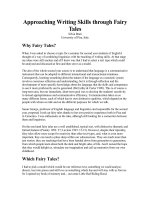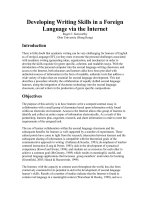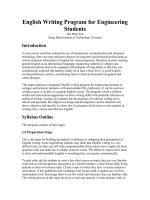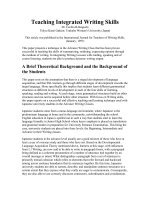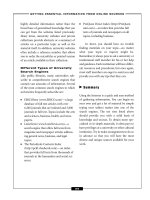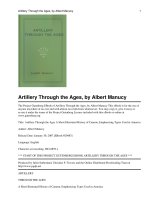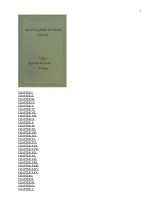Approaching Writing Skills through Fairy Tales.doc
Bạn đang xem bản rút gọn của tài liệu. Xem và tải ngay bản đầy đủ của tài liệu tại đây (107.83 KB, 9 trang )
Approaching Writing Skills through Fairy
Tales
Silvia Bruti
University of Pisa, Italy
Why Fairy Tales?
When I was asked to choose a topic for a seminar for second year students of English I
thought of a way of combining linguistics with the teaching of writing skills. At that stage
my ideas were still unclear and all I knew was that I had to select a text type which could
be analysed and discussed at first and then serve as a model.
The aim of the whole second year course is to understand that language is a communicative
instrument that can be adapted to different interactional and transactional situations.
Consequently, learning something about the nature of the language as a semiotic system
involves conscious reflection and understanding, but it is through reflection and the
development of more specific knowledge about the language that the skills and competence
to use it more proficiently can be generated (McCarthy & Carter 1990). This is of course a
long-term aim, but our immediate, short-term goal was to develop the students' sensitivity
to textual appropriateness and communicative efficiency. Communication takes on so
many different forms, each of which has its own distinctive qualities, which depend on the
people with whom we talk and on the different purposes for which we talk.
Susan George, professor of English language and linguistics and responsible for the second
year, proposed I took up fairy tales thanks to her own positive experience both in Pisa and
in Camerino. I was enthusiastic at the idea, although still looking for a connection between
them and linguistics.
On the one hand fairy tales are a well established, typical text, with distinctive thematic and
formal features (Pisanty 1993: 27; Lavinio 1993: 15-21). However, despite their tipicality,
fairy tales allow more scope for creativity than other text-types, and, what is even more
important, they can touch a place deep within our subconscious. They are much more than
just stories: they are teachings that have been handed down from generation to generation,
from which people learn about both the dark and bright sides of life. And I nursed the hope
that they would delight us, stimulate our imagination and call up memories from our own
childhood.
Which Fairy Tales?
I had to pick a model which would be our reference text, something we could analyse,
dissect, tear into pieces and still love as something which has and will stay with us forever.
So I opened my book of memory and... out came Little Red Riding Hood.
I chose it because it is a tale that is heard around the world. Perhaps it is the prototypical
fairy tale everyone has in mind.
When I began to collect some material for the seminar I was scarcely aware of the number
of different versions that spread out after the first medieval legends. I was of course
acquainted with both Perrault's tale and the version by the Grimm Brothers, but I had no
idea whatsoever that the basic plot elements of LRRH can also be found in tales from
Japan, China and Korea.
Jack Zipes (1982) has collected many versions of the tale, from the first literary versions to
the present-day politically correct adaptations. He has also commented on the history of
LRRH's textual development through centuries, by comparing texts with their illustrations.
He has shown that their referential systems are strongly interlinked and in fact, in most
cases, signs which belong to two different codes reinforce each other to the point that
images become signifiers of the signified text. I have heavily relied on Zipes's anthology,
first of all because it provided me with a reference model of a viable teaching path.
Secondarily, it was from this collection that I selected the traditional versions by Perrault
and the Grimms, Anneliese Meinert's Little Red Cap '65, Anne Sexton's poem Red Riding
Hood, Rodari's Little Green Riding Hood. I also included Angela Carter's two tales about
LRRH, The Company of Wolves and The Werewolves. But apart from the debt I owe to
Zipes, I drew most of my material from the Web. It was surfing here and there that I came
across many interesting, exciting sites devoted to fairy tales. Some of them display research
projects that are going on at different universities around the world: "Little Red Riding
Despite significant differences in language and tone, all the versions share some dominant
themes. This may explain why LRRH is so widespread around the world: it is about many
basic human themes, such as initiation to independence, family ties, obedience or
disobedience to parents, female pubescence, sexuality and/or rape, social order versus
nature, female or male heroism, death and rejuvenation, gluttony and even cannibalism. On
identifying such themes one might ask a question: are fairy tales like this for children or for
adults? Some associations in the U.S. have found some of the classical fairy tales too
overtly sexual or even subversive and have therefore proposed blacklisting them. As
Fromm (1957) and Bettelheim (1976) have pointed out, erotic material has been present in
folk and fairy tales from the very beginning. The Grimm brothers themselves consciously
adapted the tales they had collected to make them more innocent and less erotic than the
popular versions. They also restored a happy ending to LRRH, which both the folktales and
Perrault's version do not have.
In any case, Little Red Riding Hood lives on, because it can talk to anybody, especially on
account of the fact that fairy tales may be read at many different levels, and so it opens
many stimulating topics to discussion.
During the seminar I also distributed copies of other popular tales by Perrault, the Grimms
and Andersen. I wanted my students to have a small corpus of fairy tales to read and
analyse for themselves, where they could go and check the appropriateness of their own
creations. Despite the differences in style, these texts are all traditional, literary tales. So,
since I did not want to prevent the students from writing modern stories, at the risk of
infringing the limits of the genre (which sometimes happened), I also gave them examples
of modern narrative. They were some of the stories written by Roald Dahl, which display
different strategies and technique devised to appeal to a present day audience.
Which Approach?
As I have briefly touched upon above, my aim was to find a method of text criticism that
could bear some systematic relation to the development of linguistic and, more in
particular, writing skills in students, and which might also be re-applied whenever
analysing a text, be it spoken, written, literary or non literary.
In spite of what is rather commonly stated, I think that the study of a language and its
functioning mechanisms (linguistics), and literary texts (in this case fairy tales, as a literary
genre) are not mutually inimical, but can and should rather supplement each other as
integral stages in the development of both language and textual awareness. So the
employment of a linguistic framework in the reading of fairy tales was meant to produce an
inventory of the recursive linguistic forms available in that type of text but also to isolate
the relevant features of the genre, such as the situation, i.e. the writer-audience relationship,
the informative structure, the level of formality, the ratio between narrative and dialogic
text chunks, etc. Yet, this type of categorisation usually runs the risk of oversimplifying
texts in order to make them fit into some preordained framework. So I did not start by
giving any theoretical framework to my students. On the contrary, we tried to elaborate
regularities from the texts we read together, and eventually interpret deviations as instances
in which the author had broken the rule for creative purposes. The reasons were the
following:
1. I did not want to impose a fixed model which could later on curb the students'
creativity and inventiveness;
2. text-internal features are not important in themselves but in relation to other
contextual parameters such as the audience and the aim of the genre (cf. the notion
of genres as processes in Benison 1998);
3. genres are themselves dynamic objects that vary according to the needs of social
systems. Therefore new genres arise and others take on different features over time.
So it would be more precise to conceive genres as points along a continuum, with
some of them so near to one another that it becomes difficult to identify which is
which.
The selection of one text type only was constrained by the fact that I wanted my students to
develop a good awareness of at least one textual world. Therefore, exposure to many
different text types would have probably resulted in less competence, less sensitivity, or
would have required more time. The main criteria for choosing fairy-tales were usefulness
and the feasibility of application, for my students are students of languages and literature,
and are expected to produce well-written texts and critical essays. Through my choice, I
hoped to contribute to their general curriculum, so that they might re-use what they learned
in other courses, especially in written exams (e.g. the critical/literary essay in third/fourth
year exams). Our workshop was meant to analyse, anatomise texts to discover their inner
mechanism, and to understand which elements one has to employ to achieve certain
communicative functions. Apart from the immediate goal of increasing proficiency in the
written language, the pedagogical value of the second year project was to "sensitize
students to rhetorical effects, and to the rhetorical structures that tend to recur in genre-
specific texts" (Swales 1990: 213). Once they had developed such an interpretative model,
they could easily transfer it to other fields. During the seminar students wrote both
narratives and commentaries, which varied from critical evaluations to linguistic analyses
of texts. In this way their competence in both these contrasting genres was regularly
exercised.
Which Narrative Features?
Fairy tales belong to the wider category of the narrative genre, which has been extensively
analysed from many different viewpoints (Eco 1979; Marchese 1983; Pugliatti 1985;
Labov 1972; Levorato 1988). Yet, they distinguish themselves especially for the
relationship between writer and audience. In fairy tales communication is asymmetrical,
consisting in an adult author or teller who tells his tale to an audience or readership made
up of one or more children. The aim of the genre, of sub-genre, is to teach by delighting the
child, which often, if not always, implies transporting him into the world of the tale.
Therefore the author arranges his reader's textual journey before it actually starts.
Like any other kind of narrative and also like any form of formal organisation, fairy tales
are able to exploit the features of the medium they use. In particular, all verbal narratives
exploit the characteristics of language by way of encoding narrative form in linguistic
form. One of the clearest cases of encoding of narrative form in linguistic form is the use of
initial/final fixed phrases. Traditional folk tales, which belong to the oral tradition, count on
some outstanding characteristics, that is to say all the possibilities of speech, such as
prosodic phonology, intonation, the use of pauses, rhythm, the different qualities of voice,
as well as on paralinguistic codes, among which gestures, mimicry, eye contact and so on.
Written narratives cannot exploit all the devices of oral story telling, but have developed an
independent tradition of narrating with its own techniques. This is one of the first aspect
one must be aware of when dealing with narratives, and for this reason we started by
comparing the strategies of oral and written tale-telling (Lavinio 1990, 1993).
As for the content, it was essential to grasp the basic nucleus of the plot, which corresponds
to the macro-structure (van Dijk 1977). The macro structure of a narrative constitutes its
line of development from the beginning to the end and does not depend on the way in
which events are narrated, but must be reconstructed after reading the text. Macro-
structures and story-lines (a subtype of the more general category of macro-structures) are
often elaborated a priori by the author, who has the whole narrative in mind before writing,
and a posteriori by the addressee, who on the contrary processes information during the act
of reading and retains only the most basic pieces. The act of narration does not necessarily
follow a strict chronological order: quite the contrary, authors strategically exploit the
dimension of time and often call their readers to co-operate in the construction of meaning.
The basic characteristic of a story-line is that it usually involves some initial difficulty and
a final resolution. Each narrative consists of a number of episodes and sub-episodes that
make up the story line. Labov (1972) identified various components of the story line,
among which the complication and the resolution. He also distinguished other stages: the
abstract, which announces the topic of the story; the orientation, which introduces the
setting of the narrative; and the coda, which is placed at the end and can therefore perform
different functions. It can in fact comment on the events and provide the audience with a
moral lesson, or signal that the narrative has come to an end and it is time to move back to
reality. Clearly, not all stories have all these ingredients, but complication and resolution
are essential. Resolution in particular, despite its variable significance in different stories,
always brings forth a new state of affairs where order has been re-established, "by the
righting of the [initial] wrong" (Fabb 1997:165). In LRRH complication corresponds to the
meeting with the wolf and resolution to the killing of the wolf in the Grimms' version and
to the moral teaching in Perrault's one, which is not a proper resolution, since the girl dies
and the moral may only warn other children. The identification of the main stages is an
important help when students begin to write their own stories. In this way they can rely on
a schematic framework and move from simple to more complicated narratives.
When we analysed LRRH we agreed on a macro-structural plot, made up of the main
stages in the narrative, and then checked if this plot could be successfully applied to the
adaptations and re-writings. In many cases the texts did not follow the same stages, so we
just ticked those which were present, but for other texts we had to add extra stages,
especially to be able to consider fundamental details. It should also be remembered that
stages can overlap and/or some categories may have blurred margins and extend over the
whole narrative. This is the case of evaluation, in which the narrator often comments on the
resolution and expresses his view on the significance of the story (Fabb 1998: 167). This
does not necessarily occur through a moral since, as Labov (1972) and others have noticed,
narrators more frequently intersperse evaluative comments throughout their narratives with
varying degrees of explicitness.
Which Linguistic Features?
Turning now back to the linguistic features, it is worth bearing in mind that any narrative
piece is conceived to be communicated to an audience, who must be able to follow it and
understand its meaning. The linguistic form of a narrative depends partly on the genre and
partly on the audience for whom it is written.
In the telling of a tale, linguistic form communicates a part of the information and may
provide evidence for it. Our reading of fairy tales was mainly aimed to identify the most
recursive, outstanding features of the genre and the most frequent ways of encoding and
grading information in linguistic form (Taylor Torsello 1997). The procedure of scanning
texts for significant patterns is text oriented and its major purpose is to help students to get
at their own interpretation of phenomena without offering them theoretical models and
metalinguistic terminology beforehand. Once they had identified and understood the
textual aspects on which we had concentrated, it was easier for them to learn a
metalanguage for text description. My students indeed discovered things for themselves
